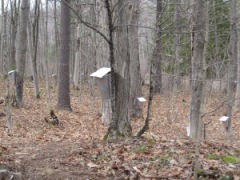It is the last day of February and sap is running in area trees already! Can you believe it? Southwestern Ontario’s mild winter means that many trees and other plants are already getting ready for spring. In fact, only yesterday I spied some sprightly little crocuses peeping their purple heads up towards the sun. March might only start tomorrow, but maple syrup producers have been collecting their liquid gold for several weeks already. At this rate, the season will be done before we know it! For those of you who don’t know the ins and outs of how maple syrup comes to be on your kitchen table, let me enlighten you a little today.
How Maple Sap Turns into Maple Syrup
As temperatures rise in early spring, trees slowly begin to wake up out of their winter dormancy. In the fall, maple trees store starch in their roots for winter use. As winter gives way to spring, warmer daytime temperatures encourage the sugary maple sap within the tree to begin rising. That is when the drills come out and stiles get tapped into place. Overnight temperatures below freezing stop the flow of sap, but the warmer daytime temperatures begin the process all over again. Once temperatures consistently remain above freezing both day and night, the season for maple syrup is at an end, as the starches no longer convert into sugar.
On average, you can tap a maple tree once it reaches about 40 years old. The larger (hence older) the tree is, the more taps it can handle. A tree that is 10 inches in diameter can have one tap, with up to 3 taps depending upon the girth of the tree; 2 taps on a 15″-20″ tree and 3 taps from 20″-25″. As long as the tree remains healthy, it can be tapped every year for upwards of a hundred years without harm to the tree. In part, that is because even though a tree provides anywhere from 35-50 litres of maple sap per season, that only accounts for approximately 10% of the sap produced. The small holes drilled into a tree are only minor blemishes for the maple. They rapidly heal, leaving behind no long-term damage.
That is a good thing, as it takes approximately 40 litres of maple sap to make 1 litre of syrup! All that sap is boiled down to evaporate most of the water in it. A thick amber syrup is the delicious final product. The high cost of pure maple syrup makes a little more sense when you crunch the numbers that way.
If you are thinking about heading to the sugar bush this year, you might want to go sooner rather than later. As the mercury steadily rises, the sap will slowly ease off and the short maple syrup season will come to a close. Don’t forget to pick up a bottle of pure Canadian maple syrup to pop into your fridge before you leave the bush. It is not only great on pancakes, but is also a source of zinc, manganese, trace amounts of calcium and potassium. Plus just darn yummy! So pour it over your waffles, add it to your baked beans and mix it into your muffins. Maple syrup season is upon us and the time is now to enjoy!





I remember when I was younger on really snowy day, heating up maple syrup and grabbing a bowl of fresh snow and pouring the hot maple syrup to make it into candy!!! YUM YUM!
I remember that myself! Not to be this year though I fear!
[…] Maple Syrup Season is Upon Us (clctreeservices.wordpress.com) […]